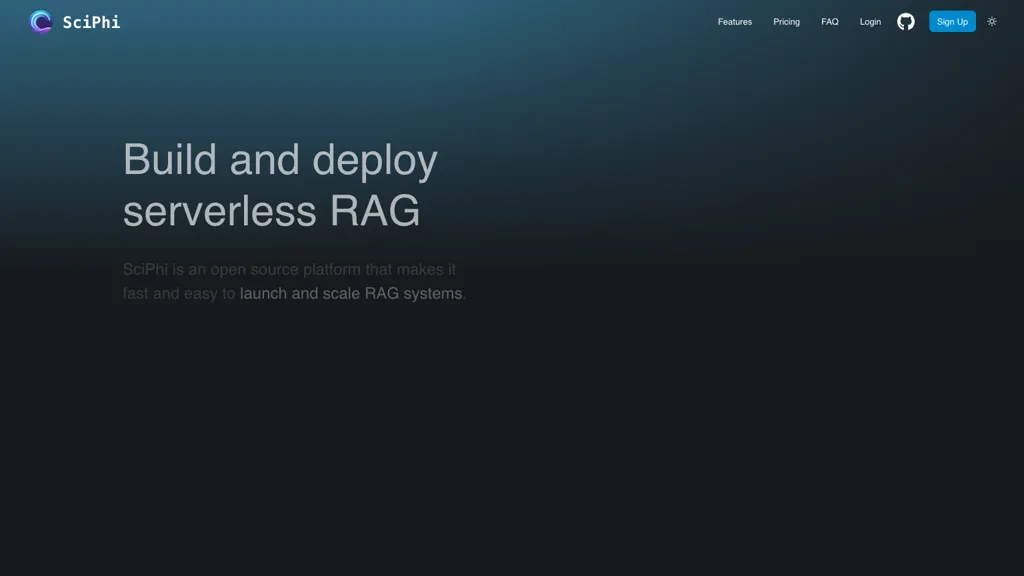What is SciPhi?
SciPhi is the first one-click serverless tool, making it easier than ever to build retrieval AI systems for developers. This open-source platform is much easier in terms of launching and scaling RAG systems. It gives high-level abstractions for clear ease of use and on-the-go deployment options that are less hassle. With SciPhi, one can create, observe, monitor embeddings, RAGs, and evaluation results in real time via autoscaling serverless deployment on the cloud.
SciPhi—Key Features & Benefits
-
One-click serverless tool:
smoothen the setup process. -
Speedy development of retrieval AI systems:
faster development timelines. -
Intuitive Abstractions:
Tame complex processes. -
Real-time observation and monitoring:
Always be at the top of performance. -
Autoscaling Serverless Deployment:
Dynamically scale to meet a workload’s ups and downs.
Unique selling points for SciPhi include the total customization of design pipelines, advanced version control via Git, and rapid deployment possibilities. Be it hosted remote providers or self-hosting, SciPhi smoothes the process of development and deployment of AI applications, thus becoming a favorite of many developers who strive for efficiency and scalability in their projects.
SciPhi Use Cases and Applications
SciPhi is a flexible tool that can be applied in a number of cases:
-
Knowledge retrieval AI system:
This will be very instrumental in the medical records dataset. It allows for real-time monitoring of embeddings and evaluation results. -
Q&A AI model:
Ideally fitted for customer support questions, this needs autoscaling serverless deployment for seamless scaling, and advanced version control with Git. -
Recommendation system:
Very suitable for e-commerce sites, this has intuitive abstractions that come with fast deployment, which allows for full customization and real-time performance monitoring.
It serves a large user base of AI developers, data engineers, machine learning engineers, and cloud architects.
How to Use SciPhi
Getting started with SciPhi is relatively painless and involves the following steps:
-
Sign Up:
Create an account on the SciPhi platform. -
Select a Plan:
Choose between a free, startup, or enterprise plan depending on your needs. -
Set up your environment:
Configure the development environment by using the one-click serverless tool. -
Design Your AI System:
Develop and deploy your AI models at your convenience using SciPhi’s intuitive abstractions. -
Monitor and Scale:
See real-time performance and use autoscaling to automatically manage resources. -
Best Practices:
Keep regular version control with Git, and leverage real-time monitoring from the platform to further tune your systems as needed.
How SciPhi Works
SciPhi operates on a serverless architecture, which means it dynamically scales its resources with the current load to ensure efficient and scalable deployment. This tool comes with advanced algorithms in monitoring and retrieving embeddings to provide real-time insight into the performance of the system.
It typically sets up the environment, designs an AI system using abstractions provided, deploys the model, and continuously monitors and scales up based on performance metrics. This makes SciPhi seamless in terms of integration for development and deployment processes in building sophisticated AI systems.
Pros and Cons of SciPhi
Several pros exist in using SciPhi, including:
-
Efficiency:
One-click serverless deployment saves time and reduces complexity. -
Scalability:
Autoscaling to follow varied workloads, customization in giving total control over design pipelines to provide solutions that are customized, and real-time monitoring to provide continuous insights regarding system performance.
On the downside, one would consider:
-
Learning Curve:
It may take a little time to study all its features. -
Cost:
Advanced features will increase pricing plans.
Users generally comment on the efficiency and scalability of the platform, although some of them indicate that the setup might be a little tricky for the first time in case no experience is available.
Conclusion about SciPhi
SciPhi is a great tool in the hands of developers who want to build and scale AI retrieval systems with much ease. Its serverless architecture, intuitive abstractions, and real-time monitoring set it apart in the AI development space. Added to that is, of course, an added learning curve; however, benefits in customization, scalability, and streamlined deployment make it well worth the cost. No doubt that updates and enhancements will continue in the future, sealing its place as a leading AI developer tool.
SciPhi FAQs
-
What is SciPhi?
SciPhi is a one-click serverless tool that efficiently builds and scales retrieval AI systems. -
Who has a use for SciPhi?
It’s useful for AI developers, data engineers, machine learning engineers, and cloud architects in their work. -
What are the pricing options for SciPhi?
SciPhi offers a free plan, a $249 per month startup plan, and a custom enterprise plan. -
What are some common use cases for SciPhi?
Some of the common use cases are the development of knowledge retrieval systems over large databases, question answering AI models for customer support, and personalized recommendation systems over e-commerce platforms. -
How does SciPhi ensure scalability?
SciPhi uses autoscaling serverless deployment in order to dynamically allocate resources based on current demand.










